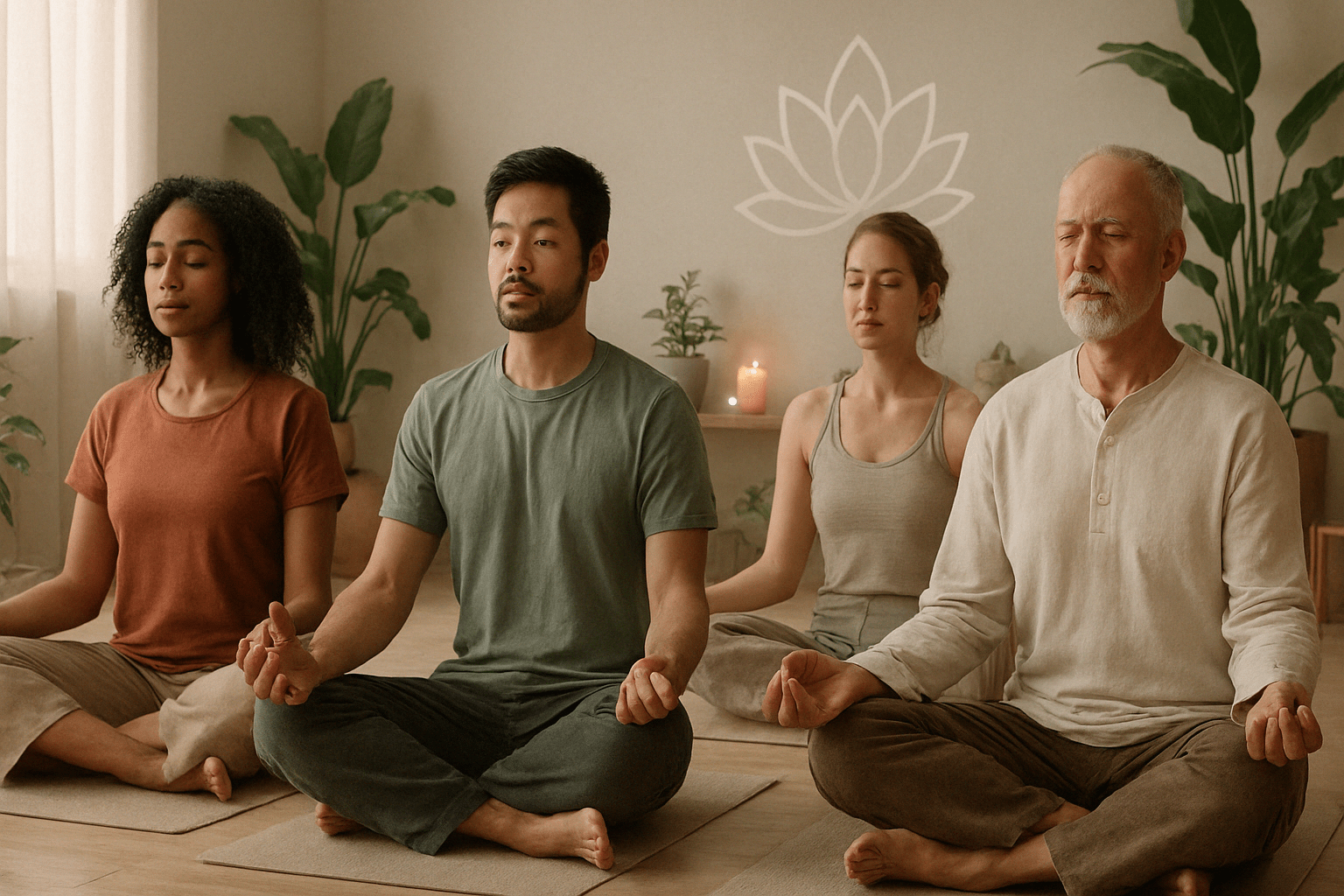Meditation has long been a cornerstone in the pursuit of inner peace and healing. With its powerful ability to calm the mind, reduce stress, and enhance emotional well-being, it is no surprise that people around the world are incorporating meditation into their daily lives. One of the best ways to deepen your practice is by taking a meditation class. Whether you are a beginner or experienced practitioner, attending a meditation class offers structured guidance and techniques that can help you unlock your potential and experience profound healing. In this article, we’ll guide you through essential meditation tips, different meditation techniques, and how attending a meditation class can lead you to true inner peace and healing.
Table of Contents
1. Why Choose a Meditation Class?
Tip: Structured meditation classes provide essential guidance and support.
While meditation can be practiced on your own, joining a meditation class offers several benefits, especially for beginners. Classes typically provide a structured approach to meditation, which can be helpful in building a consistent practice. A qualified instructor will offer guidance on various meditation techniques, making it easier for you to dive deep into your practice and gain the benefits of inner peace and healing.

Step by Step:
- Find a meditation class that suits your needs, whether online or in-person.
- Set aside regular time to attend the class to build consistency.
- Practice the techniques taught in class regularly to improve your skills and deepen your meditation experience.
- Ask the instructor questions if you are unsure about the techniques or need guidance.
Why It Works:
A meditation class provides both structure and community. It allows you to ask questions and receive feedback, ensuring that you practice the techniques correctly. Additionally, classes foster a supportive environment, helping you stay motivated and committed to your meditation practice.

2. Meditate While You Exercise
Tip: Turn your workout routine into a meditation session.
Exercise and meditation don’t have to be separate practices. By incorporating meditation into your workout routine, you can deepen your mindfulness and gain greater emotional clarity while also benefiting from physical activity. Whether you’re walking, running, doing yoga, or stretching, you can integrate meditation techniques into your exercise for a truly holistic practice.
Step by Step:
- Choose a physical activity that you enjoy, such as walking, running, or yoga.
- Instead of listening to music or focusing solely on your movements, bring mindfulness into your practice.
- Focus on your breath as you move through each exercise or step. Pay attention to how your body feels and any sensations that arise.
- Allow your thoughts to pass without judgment and bring your attention back to your breath and body.
Why It Works:
By combining meditation with exercise, you can synchronize your body and mind, leading to a deeper sense of peace and presence. This mindful approach to exercise can enhance the benefits of both practices, promoting overall well-being.
3. Mindfulness Meditation for Inner Peace
Tip: Use mindfulness meditation to cultivate awareness and reduce stress.
Mindfulness meditation is one of the most popular and effective forms of meditation for achieving inner peace. The practice encourages you to stay present and aware of your thoughts, feelings, and sensations without judgment. This helps reduce anxiety, stress, and overthinking, fostering a peaceful mental state.
Step by Step:
- Sit comfortably in a quiet space, close your eyes, and take a few deep breaths to relax.
- Focus on your breath as it moves in and out of your body. If your mind begins to wander, gently bring your focus back to your breath.
- Observe any thoughts or feelings that arise, but don’t get attached to them. Let them pass like clouds in the sky.
- Continue for 10-20 minutes, allowing your mind to settle and your body to relax.
Why It Works:
Mindfulness meditation trains your mind to be present, which helps reduce stress and fosters a sense of peace. Over time, this practice can improve emotional resilience, helping you deal with challenges in a calm and balanced way.
4. Guided Meditation for Healing
Tip: Use guided meditation to promote deep healing and relaxation.
Guided meditation can be particularly beneficial when you want to enhance your healing process. With the help of an instructor or a recorded session, guided meditations lead you through a series of visualizations, affirmations, or breathing exercises aimed at healing your body, mind, and spirit.
Step by Step:
- Find a guided meditation that focuses on healing. There are many options available online, targeting specific areas like emotional healing, stress reduction, or physical health.
- Sit in a comfortable position, close your eyes, and listen to the guide’s voice.
- Follow the instructions, which may include visualizing healing energy entering your body or affirming positive statements about your health and well-being.
- Allow the experience to wash over you, focusing on relaxation and healing.
Why It Works:
Guided meditations provide a structured experience that can be very helpful for those new to meditation or anyone looking for extra support in their healing journey. The guidance can help you stay focused and deepen the healing process.
5. Breathing Techniques to Calm the Mind
Tip: Practice focused breathing to reduce stress and increase clarity.
Breathing exercises are an essential component of meditation and can be easily incorporated into any session. Learning how to control your breath helps activate your body’s relaxation response, calming the nervous system and bringing mental clarity.
Step by Step:
- Sit in a comfortable, upright position with your eyes closed.
- Begin by taking a deep breath in through your nose for a count of four.
- Hold your breath for a count of four.
- Slowly exhale through your mouth for a count of six, emptying your lungs completely.
- Repeat this cycle for several minutes, focusing solely on your breath.
Why It Works:
Breathing exercises help regulate your body’s stress response, promoting relaxation and clarity. By focusing on your breath, you can calm your mind and enhance your meditation practice.
6. Meditation for Emotional Healing
Tip: Use meditation to heal emotional wounds and foster emotional balance.
Emotional healing is an integral part of meditation. The practice provides a safe space for processing emotions, letting go of negative feelings, and nurturing emotional well-being. By regularly practicing meditation, you can clear emotional blockages and move toward a balanced emotional state.
Step by Step:
- Sit in a quiet place and focus on your breath.
- When emotions arise, simply observe them without judgment.
- Visualize healing light or energy surrounding your emotional wounds, bringing calm and balance.
- Allow the healing process to unfold as you continue to breathe deeply and relax.
Why It Works:
Meditation allows you to process emotions in a healthy way, reducing the impact of past experiences on your present life. Over time, this practice can improve emotional resilience and promote long-term healing.
7. Visualization for Manifestation
Tip: Visualize your ideal life to manifest inner peace and healing.
Visualization is a powerful meditation technique that can help you manifest positive changes in your life. By vividly imagining your goals and desires, you can direct your energy toward attracting the outcomes you wish to experience. It’s particularly effective for cultivating inner peace and healing.
Step by Step:
- Sit in a comfortable position and close your eyes.
- Begin by taking a few deep breaths to center yourself.
- Visualize your ideal self – one that is peaceful, balanced, and healed.
- Imagine this peaceful version of yourself living in harmony with the world around you, radiating positive energy.
- Focus on how you feel in this vision, allowing yourself to fully embody the experience.
Why It Works:
Visualization helps focus your intentions, creating a mental picture of the life you wish to manifest. This practice encourages positive thinking and helps bring about the changes you seek.
8. Use Affirmations During Meditation
Tip: Incorporate positive affirmations to boost your meditation practice.
Affirmations are powerful tools for reprogramming your subconscious mind. When practiced during meditation, they can help you cultivate positive beliefs, promote healing, and strengthen your inner peace. By repeating affirmations, you align your thoughts with your desired outcomes, helping manifest peace and healing in your life.
Step by Step:
- Sit comfortably, close your eyes, and take a few deep breaths to relax your body.
- Begin repeating affirmations that resonate with you, such as “I am at peace,” “I am healing,” or “I am deserving of love and happiness.”
- Focus on the meaning of the affirmations, allowing each word to penetrate your mind and body.
- Continue repeating the affirmations, letting them sink deeply into your subconscious mind.
Why It Works:
Affirmations strengthen the power of your thoughts, reinforcing positive beliefs and promoting emotional healing. When practiced during meditation, affirmations can deepen the impact of your mental shifts and help manifest a peaceful, healed state.

Conclusion
Meditation is a transformative practice that can lead to profound inner peace and healing. By attending a meditation class, you gain access to expert guidance and support, allowing you to deepen your practice and unlock your full potential. Whether you choose mindfulness meditation, guided sessions, or incorporating meditation into your exercise routine, the key to success lies in consistency. By making meditation a regular part of your life, you can experience lasting peace, emotional balance, and healing.

